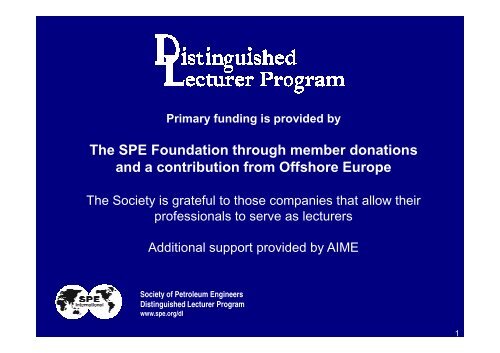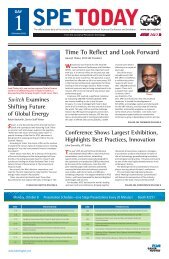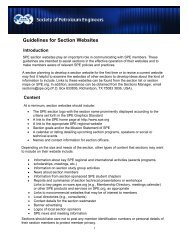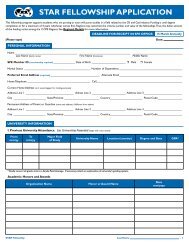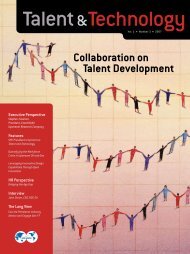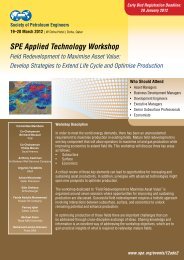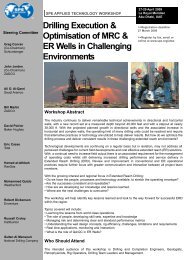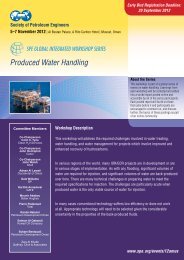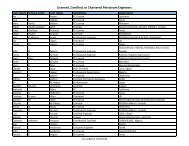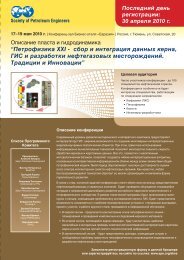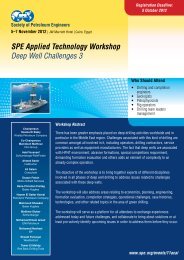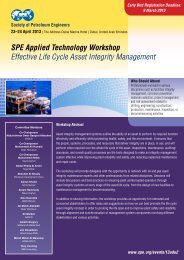Managed Pressure Drilling - Drill the Un-Drillable - Society of ...
Managed Pressure Drilling - Drill the Un-Drillable - Society of ...
Managed Pressure Drilling - Drill the Un-Drillable - Society of ...
Create successful ePaper yourself
Turn your PDF publications into a flip-book with our unique Google optimized e-Paper software.
Primary funding is provided by<br />
The SPE Foundation through member donations<br />
and a contribution from Offshore Europe<br />
The <strong>Society</strong> is grateful to those companies that allow <strong>the</strong>ir<br />
pr<strong>of</strong>essionals to serve as lecturers<br />
Additional support provided by AIME<br />
<strong>Society</strong> <strong>of</strong> Petroleum Engineers<br />
Distinguished Lecturer Program<br />
www.spe.org/dl<br />
1
<strong>Managed</strong> <strong>Pressure</strong> <strong><strong>Drill</strong>ing</strong>:<br />
<strong>Drill</strong> <strong>the</strong> <strong>Un</strong>-<strong>Drill</strong>able<br />
Lecturer’s Name: Hani Qutob<br />
Reservoir Engineering & UBD/MPD Advisor<br />
Senergy GB Limited– Dubai, UAE<br />
<strong>Society</strong> <strong>of</strong> Petroleum Engineers<br />
Distinguished Lecturer Program<br />
www.spe.org/dl<br />
2
Presentation Outlines<br />
• Reservoir Engineering & Advanced <strong><strong>Drill</strong>ing</strong> Technology<br />
• Advanced <strong><strong>Drill</strong>ing</strong> Technology Variations<br />
• What is <strong>Managed</strong> <strong>Pressure</strong> <strong><strong>Drill</strong>ing</strong>?<br />
• Optimal Redefined Time/Cost line<br />
• Variables that can be Manipulated during MPD<br />
• What Are <strong>the</strong> Main MPD Benefits?<br />
• <strong>Managed</strong> <strong>Pressure</strong> <strong><strong>Drill</strong>ing</strong> Variations.<br />
• Health, Safety and Environment Issues<br />
• Case Histories obtained worldwide.<br />
• Conclusions<br />
• Acknowledgement<br />
3
Advanced <strong><strong>Drill</strong>ing</strong> Technology ® (ADT ® )<br />
& Reservoir Benefits<br />
How ADT ® can increase reserves and improve recovery<br />
Minimizes Formation Damage - UBD.<br />
Accesses Challenging Reservoirs - MPD.<br />
Improves Reservoir Characterization - UBD<br />
Identifies Missed Pay – UBD.<br />
Increases Production & Enhances Recovery<br />
- UBD / MPD<br />
4
How <strong>Managed</strong> <strong>Pressure</strong> <strong><strong>Drill</strong>ing</strong> – MPD Benefits <strong>the</strong><br />
Reservoir?<br />
By: Accessing Challenging Reservoirs<br />
The single biggest reserve contribution <strong>of</strong> MPD is found to be<br />
access to reservoirs that could not be drilled conventionally.<br />
In almost all cases, MPD is used in challenging or partially<br />
depleted reservoirs, only after conventional wells prove<br />
expensive, unsuccessful or un-drillable<br />
Some reservoirs that could be difficult to access using<br />
conventional drilling techniques are:<br />
1. Low pressure & depleted reservoirs<br />
2. Vuggy/fractured carbonates where OB circulation is<br />
impossible<br />
3. Reservoirs with a narrow margin between fracture<br />
pressure and pore pressure - kicks/losses cycles<br />
5
Advanced <strong><strong>Drill</strong>ing</strong> Technology ® (ADT ® )<br />
ADT ® is an adaptive drilling process which enables a more<br />
precise control <strong>of</strong> wellbore pressures through <strong>the</strong> use <strong>of</strong><br />
engineered equipment & processes.<br />
ADT ® Variations<br />
Air <strong><strong>Drill</strong>ing</strong><br />
Improve <strong><strong>Drill</strong>ing</strong> Economics - Intent is to invite surface flow<br />
Primarily non-liquid hydrocarbon formations<br />
<strong>Un</strong>derbalanced <strong><strong>Drill</strong>ing</strong>:<br />
Maximize Reservoir Value - Intent is to invite surface flow<br />
<strong>Managed</strong> <strong>Pressure</strong> <strong><strong>Drill</strong>ing</strong>:<br />
6<br />
Optimize <strong><strong>Drill</strong>ing</strong> Process - Intent is not to invite surface flow
What is common in ADT Variations?<br />
Personnel<br />
and<br />
Equipment<br />
7
UBD , MPD & Conventional<br />
8
What is <strong>Managed</strong> <strong>Pressure</strong> <strong><strong>Drill</strong>ing</strong>?<br />
A closed and<br />
pressurizable<br />
mud-return<br />
system, a<br />
Rotating Control<br />
Head, and choke.<br />
operations<br />
provide precise<br />
control <strong>of</strong> <strong>the</strong><br />
wellbore pressure<br />
pr<strong>of</strong>ile.<br />
9
Reactive vs Proactive MPD<br />
Reactive<br />
Effective on “standby”<br />
basis as an enhanced<br />
form <strong>of</strong> passive well<br />
control to help manage<br />
unexpected downhole<br />
pressure.<br />
Proactive<br />
Used to mitigate drilling<br />
hazards and reduce NPT<br />
by changes to fluid,<br />
casing and open-hole<br />
programs<br />
10
We like prospects with big drilling windows…<br />
Overburden<br />
Fracture<br />
Depth<br />
Collapse<br />
Pore<br />
<strong>Pressure</strong><br />
EMW Must Stay Within <strong><strong>Drill</strong>ing</strong> Window For <strong><strong>Drill</strong>ing</strong> To Progress<br />
11
Remaining prospects not cooperating very well<br />
Very narrow or relatively un-known margins<br />
Difficult or impossible to drill conventionally<br />
Overburden<br />
Depth<br />
When MPD is used?<br />
• Kick-Loss Scenarios<br />
• High mud bill<br />
• Excessive casing string(s)<br />
• <strong><strong>Drill</strong>ing</strong> NPT – Exceeding AFE<br />
• Environmental issues<br />
Collapse<br />
• Failure to reach TD with large<br />
enough hole for optimum well production<br />
• Or…simply ….“not drillable”<br />
Pore<br />
Fracture<br />
<strong>Pressure</strong><br />
12
Small <strong><strong>Drill</strong>ing</strong> “Window”<br />
Fluid Losses<br />
Fluid Losses<br />
Bottom Hole Circulating<br />
<strong>Pressure</strong><br />
Fracture <strong>Pressure</strong><br />
Pore <strong>Pressure</strong> – Collapse Boundary<br />
Influx – Tight Hole Influx – Tight Hole<br />
Constant Bottom Hole <strong>Pressure</strong><br />
Time<br />
13
MPD VALUE - VISUALIZATION<br />
Real Well – Case 1<br />
Time (days)<br />
5000000<br />
5500000<br />
6000000<br />
Accum ultaed cost<br />
6500000<br />
7000000<br />
7500000<br />
0 1 2 3 4 5 6 7 8 9 10 1112 13 1415 16 17 1819 20 2122 23 2425 26 2728 29 30 3132 33 3435 36<br />
Stuck pipe<br />
Fishing<br />
10.3% <strong>of</strong> total cost<br />
11.0% <strong>of</strong> total cost<br />
Cost<br />
Time - Depth<br />
8000000<br />
2600<br />
Stuck pipe<br />
Well flowing<br />
8500000<br />
2700<br />
Losses<br />
Circulating,<br />
0 1<br />
Cement<br />
2 3 4squeeze<br />
5 6 7 8 9 10 1112 13 1415 16 17 1819 20 2122 23 2425 26 2728 29 30 3132 33 3435 36 23%<br />
Time (days)<br />
2100<br />
2200<br />
2300<br />
2400<br />
2500<br />
Measured Depth (m)<br />
Well control,<br />
10%<br />
NPT distribution<br />
Stuck pipe,<br />
55%<br />
POOH, 3%<br />
RIH, 4%<br />
Reaming, 5%
MPD VALUE - VISUALIZATION<br />
Real Well – Case 2<br />
Time (days)<br />
900000<br />
1400000<br />
1900000<br />
0 2 4 6 8 10 12 14 16 18 20 22 24 26 28 30 32 34 36 38 40 42 44 46 48 50 52 54 56 58 60 62 64<br />
Cost<br />
2.3% Time - Depth<br />
10.5%<br />
1800<br />
1900<br />
2000<br />
Accumulated cost<br />
2400000<br />
2900000<br />
Losses<br />
Cement squeeze<br />
20.9% total cost<br />
2100<br />
2200<br />
Measured Depth (m)<br />
3400000<br />
3900000<br />
Gas kick, well control<br />
Cement plug<br />
Sidetrack<br />
17.7% <strong>of</strong> total cost<br />
Losses<br />
Cement plug<br />
Total losses<br />
Gas flow<br />
2300<br />
2400<br />
Time distribution (well)<br />
0 2 4 6 8 10 12 14 16 18 20 22 24 26 28 30 32 34 36 38 40 42 44 46 48 50 52 54 56 58 60 62 64<br />
Time (days)<br />
NPT, 45%<br />
Effective time,<br />
55%
Optimal Redefined Time/Cost line<br />
0<br />
100<br />
200<br />
300<br />
Pore P. Frac. P.<br />
Optimal time<br />
Saving in <strong><strong>Drill</strong>ing</strong> Time<br />
Conventional drilling (NPT)<br />
400<br />
500<br />
600<br />
700<br />
800<br />
900<br />
1000<br />
1100<br />
1200<br />
1300<br />
1400<br />
1500<br />
1600<br />
1700<br />
1800<br />
1900<br />
Depth<br />
$ vs NPT<br />
MPD application is<br />
focused on achieving<br />
<strong>the</strong> well construction<br />
“Optimal time and<br />
Cost” as objective<br />
$ vs NPT<br />
Saving in <strong><strong>Drill</strong>ing</strong> Cost<br />
Optimal Cost<br />
Case<br />
Conventional cost due to high NPT<br />
16
Conventional <strong><strong>Drill</strong>ing</strong><br />
Bottom hole circulating pressure is<br />
manipulated by only two variables.<br />
BHCP conventional = Hydrostatic <strong>Pressure</strong><br />
Affected by Density<br />
+ ∆P friction<br />
Affected by density<br />
and flow rate<br />
17
<strong>Managed</strong> <strong>Pressure</strong> <strong><strong>Drill</strong>ing</strong><br />
.<br />
BHCP MPD = Hydrostatic <strong>Pressure</strong><br />
Affected by density<br />
+ ∆p friction<br />
+ Choke<br />
Affected by density<br />
and flow rate<br />
Manipulated<br />
from surface<br />
18
Variables that can be<br />
Manipulated<br />
Variable<br />
Mud density<br />
Mud viscosity<br />
Flow rate<br />
Trapped <strong>Pressure</strong><br />
Friction <strong>Pressure</strong><br />
Equipment<br />
Rotating Control Head<br />
Choke Manifold<br />
Mud pumps<br />
Downhole pump<br />
19
In what cases can MPD add value?<br />
<strong>Drill</strong> to <strong>the</strong> target<br />
<strong><strong>Drill</strong>ing</strong> Exploratory, Appraisal or Challenging<br />
Development wells<br />
<strong>Drill</strong> conventionally “<strong>Un</strong>-drillable” tight Pore<br />
/Collapse /Fracture pressure gradients<br />
<strong>Drill</strong> “<strong>Un</strong>-drillable” vuggy/ fractured carbonates<br />
where Over Balanced circulation is impossible<br />
20
What Are MPD Benefits?<br />
Cost Saving<br />
• Reduced number <strong>of</strong> loss/kick occurrences<br />
• Reduced time spent dealing with well control events<br />
• Earlier kick / losses detection<br />
• Optimized number <strong>of</strong> casing strings<br />
Improved Safety<br />
• Trip safely<br />
• Remove H 2 S hazard from rig floor<br />
• <strong>Drill</strong> HPHT wells safely<br />
21
MPD – Added <strong><strong>Drill</strong>ing</strong> Performance Value<br />
Geo-mechanical Issues<br />
22
MPD Variations – Visualization<br />
Returns-flow-control (HSE)<br />
Constant Bottom Hole<br />
<strong>Pressure</strong> (CBHP)<br />
MPD<br />
Pressurized mud-cap drilling<br />
Dual gradient MPD<br />
23
MPD Official Definition<br />
An adaptive drilling process used to precisely control <strong>the</strong> annular pressure pr<strong>of</strong>ile throughout<br />
<strong>the</strong> wellbore. The objectives are to ascertain <strong>the</strong> downhole pressure environment limits and to<br />
manage <strong>the</strong> annular hydraulic pressure pr<strong>of</strong>ile accordingly. MPD is intended to avoid<br />
continuous influx <strong>of</strong> formation fluids to <strong>the</strong> surface. Any influx incidental to <strong>the</strong> operation will<br />
be safely contained using an appropriate process.<br />
<strong><strong>Drill</strong>ing</strong> Connection <strong><strong>Drill</strong>ing</strong> – Change in required BHP<br />
<strong><strong>Drill</strong>ing</strong> Connection <strong><strong>Drill</strong>ing</strong> – Change in required BHP<br />
Equivalent Circulating Density (ppg)<br />
Required BHP (Pore <strong>Pressure</strong> + Margin)<br />
Circulating<br />
Friction<br />
Hydrostatic<br />
<strong>Pressure</strong><br />
Reduction<br />
in BHP<br />
Hydrostatic<br />
<strong>Pressure</strong><br />
Circulating<br />
Friction<br />
Hydrostatic<br />
<strong>Pressure</strong><br />
New<br />
Circulating<br />
Friction<br />
New<br />
Hydrostatic<br />
<strong>Pressure</strong><br />
Required BHP (Pore <strong>Pressure</strong> + Margin)<br />
Surface<br />
Backpressure<br />
Circulating<br />
Friction<br />
Hydrostatic<br />
<strong>Pressure</strong><br />
Modified<br />
Surface<br />
Backpressure<br />
Hydrostatic<br />
<strong>Pressure</strong><br />
Surface<br />
Backpressure<br />
Circulating<br />
Friction<br />
Hydrostatic<br />
<strong>Pressure</strong><br />
New<br />
Surface<br />
Backpressure<br />
Same<br />
Circulating<br />
Friction<br />
Same<br />
Hydrostatic<br />
<strong>Pressure</strong><br />
Time / Depth<br />
Conventional <strong><strong>Drill</strong>ing</strong> Practices<br />
Time / Depth<br />
<strong>Managed</strong> <strong>Pressure</strong> <strong><strong>Drill</strong>ing</strong>
Risk Management<br />
With all MPD operations a detailed risk assessment<br />
as well as a HAZID and HAZOP should be carried out<br />
with <strong>the</strong> rig crew supervisors and <strong>the</strong> relevant service<br />
providers and operator staff.<br />
<strong>Un</strong>derstanding <strong>the</strong> sequence <strong>of</strong> events and when to<br />
initiate MPD operations and discussing <strong>the</strong> rig up,<br />
pressure testing and operational aspects <strong>of</strong> a job<br />
toge<strong>the</strong>r with all <strong>of</strong> <strong>the</strong> procedures will help to ensure<br />
<strong>the</strong> maximum success for an MPD operation.
Health, Safety and Environment Issues<br />
• HAZOPs and HAZIDs are both systematic<br />
processes to identify hazards.<br />
• “You cannot manage what you don’t know.”<br />
26
No Compromise on Rig safety – all rig safety<br />
Equipment Remains unchanged<br />
27
Case History 1 – Middle East<br />
Objectives<br />
8 3/8” Section<br />
Performance<br />
Total days spent<br />
on drilling <strong>the</strong><br />
section<br />
To reach <strong>the</strong> target depth with minimum NPT<br />
To avoid uncontrolled event by maintaining a<br />
constant bottom hole pressure<br />
Offset<br />
Well<br />
MPD<br />
Well<br />
on drilling <strong>the</strong> 65 40<br />
Total days spent<br />
on well control<br />
events (NPT)<br />
Total days spent<br />
on tight<br />
hole/reaming<br />
7.6 1.1<br />
2.8<br />
days<br />
19<br />
hours<br />
Saudi Arabia<br />
(Onshore)<br />
28
Case History 2 – North Africa<br />
Algeria – drilling through high fractured zone<br />
<strong>Un</strong>-drillable Reservoir<br />
<strong>Drill</strong>ed<br />
A total <strong>of</strong> 191 m were<br />
drilled with a very small<br />
drilling window.<br />
Zero LTI’s or near misses<br />
recorded on this well.<br />
Avoided kick/loss cycles &<br />
Improved ROP.
Case History 3: Offshore India<br />
MPD Added Value<br />
NPT reduced to 1 day<br />
compared to 10 days<br />
experienced in <strong>the</strong> three<br />
previous wells drilled.<br />
LOC & Fluid losses<br />
minimized to 290 BBL<br />
compared to 4000 BBL<br />
on previous wells.<br />
Avoided kick/loss cycles<br />
& Improved ROP.
Case History 4 – South America<br />
Petrobras Colombia Limited,<br />
MPD Added Value<br />
No Loss <strong>of</strong> Circulation<br />
significant cost savings<br />
31
Case History 5 – Canada<br />
Nor<strong>the</strong>astern British Columbia,<br />
MPD Added Value<br />
Reduced AFE by approximately<br />
19% (saving Can$ 2 Million).<br />
<strong><strong>Drill</strong>ing</strong> efficiency was improved<br />
by lowering <strong>the</strong> mud weight and<br />
doubling <strong>the</strong> ROP .<br />
Considered MPD techniques to<br />
increase drilling effectiveness in<br />
this field.<br />
32
MPD application in Vietnam<br />
BIEN DONG POC HPHT Gas Condensate Development<br />
BLOCK 05-2 & 05-3 Offshore -Vietnam<br />
Why MPD on this project?<br />
Narrow margin <strong>of</strong> PP/FG pressure<br />
in both fields.<br />
Early kick detection & control.<br />
Better well control in HPHT wells.<br />
<strong>Drill</strong> wells to target depth and<br />
eliminate additional casing string.<br />
Providing CBHP during static and<br />
dynamic conditions which mitigates<br />
stress caging (SC).<br />
33
Project Overview<br />
Phase-1: total sixteen (16) wells:<br />
6 wells in block 05-3 (Moc Tinh)<br />
10 wells in block 05-2 (Hai Thach)<br />
Contract status: singed for 4.5 years + potential<br />
extension.<br />
34
Conclusions<br />
The challenging hydraulics <strong>of</strong> <strong>the</strong> world’s remaining<br />
prospects indicate MPD will evolve to become a<br />
key enabling technology.<br />
<strong>Managed</strong> <strong>Pressure</strong> <strong><strong>Drill</strong>ing</strong> technology is increasingly<br />
being applied in reservoirs that are difficult to drill<br />
conventionally (<strong>Un</strong>-drillable), deep water and High<br />
<strong>Pressure</strong>, High Temperature (HPHT) wells to<br />
access HC reserves, enhance operational safety<br />
and efficiency.<br />
All “first adopters” <strong>of</strong> MPD <strong>of</strong>fshore plan future wells.<br />
35
Conclusions (cont’d)<br />
<strong>Managed</strong> <strong>Pressure</strong> <strong><strong>Drill</strong>ing</strong> can reduce<br />
well costs as a result <strong>of</strong>;<br />
– Reduced number <strong>of</strong> casings = Smaller<br />
casings = smaller rig<br />
– Less consumables (mud and cement)<br />
– Less materials and logistics cost<br />
Additional Benefits <strong>of</strong> MPD:<br />
– Faster drilling<br />
– Reduced formation damage<br />
– Improved productivity = improved recovery<br />
– Reduced environmental impact<br />
36
Wrap-Up<br />
Proper candidate screening is a deliberate process, and is a<br />
critical step in <strong>the</strong> design <strong>of</strong> a successful ADT operation.<br />
Detailed economic analysis is an important step to<br />
determine <strong>the</strong> benefit that MPD could provide compared to<br />
competing conventional drilling & completion technologies.<br />
Poor screening and planning results in an over-enthusiastic<br />
misapplication <strong>of</strong> <strong>the</strong> technology, and possibly failure.<br />
Proper Project management, engineering and execution is a<br />
key factor for a successful MPD operation.<br />
37
Your Feedback is Important<br />
Enter your section in <strong>the</strong> DL Evaluation Contest by<br />
completing <strong>the</strong> evaluation form for this presentation :<br />
Click on: Section Evaluation<br />
<strong>Society</strong> <strong>of</strong> Petroleum Engineers<br />
Distinguished Lecturer Program<br />
www.spe.org/dl 38
Speaker contact details<br />
Hani Qutob<br />
Reservoir Engineering<br />
& UBD-MPD Advisor<br />
Senergy GB Limited<br />
Dir: +971 4 387 3022<br />
BB: +971 5 0622 4513<br />
M: +971 5 0657 7328<br />
F: +971 2 667 0408<br />
E: Hani.Qutob@senergyworld.com<br />
W: www.senergyworld.com
To advance your career and keep up<br />
to date with technology, join;<br />
40


